Penske's last great unfair advantage
Clever rule-reading plus IImor's super secret engine helped Roger Penske's savvy team dominate Indy in '94 - but it turned out to be a one-off opportunity
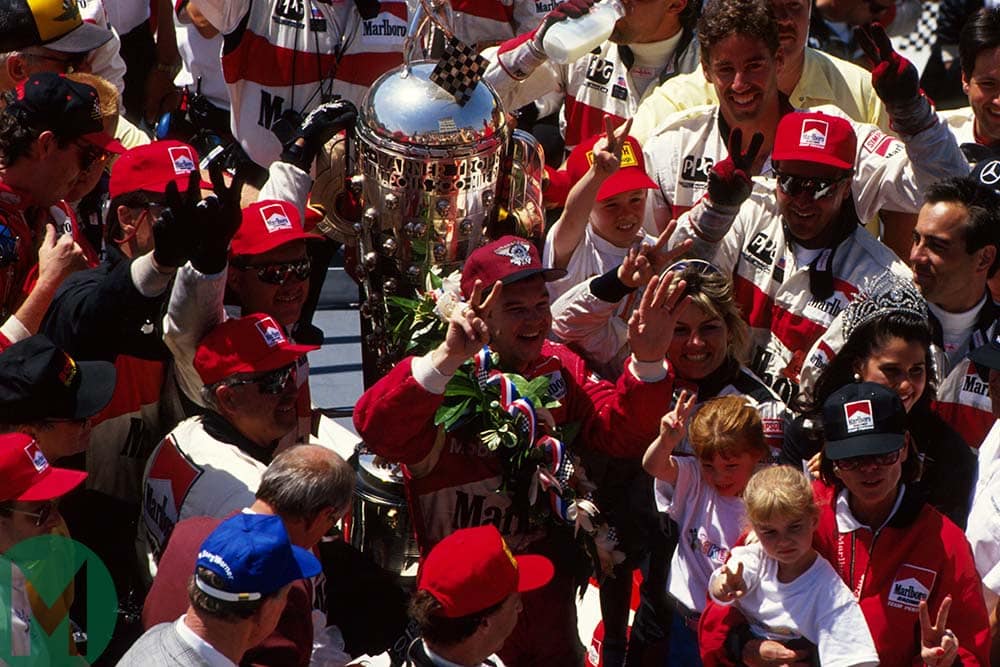
Al Unser Jr celebrates winning the 1994 Indy 500 for Penske-Mercedes
Motorsport Images
The impossible dream for any engine builder, team or driver is to substantially out-power the opposition and beat them on fuel economy too. In 1994 this chimera was briefly achieved by Roger Penske’s team, when Penske and Ilmor engine designer Mario Illien took advantage of USAC rewriting its rulebook to design, build and develop in great secrecy the single-camshaft rocker-arm 3.4-litre (209 cubic inch) Mercedes-Benz turbo V8, with which Al Unser Jr and Emerson Fittipaldi dominated that year’s Indy 500.
Fittipaldi lapped the field and Unser won easily after Emmo led most of the race only to crash while trying to put Al Jr a lap behind. In the weeks following the race USAC reacted by severely restricting the turbo boost pressure for single-cam engines, effectively banning the motor in favour of the conventional 2.65-litre four-cam engines raced by the other teams. The ‘209’ never raced again.
In those days the owners’ organisation, CART, ran the championship known as the Indy Car World Series, but USAC prevailed as the sanctioning body at Indianapolis. Hoping to promote the use of American ‘stock-block’ engines, USAC had long permitted stock-blockbased, single-camshaft engines with 750cc more swept volume and considerably more boost than the four-cam racing engines used by most CART teams. In 1991 Gary Bettenhausen was the fastest qualifier at Indianapolis aboard a turbo Buick-powered Lola, and the following year Roberto Guerrero was on pole in a similar car.
“Time after time we kept seeing the Buicks running fast and blowing everybody off for pole, but then they’d break down in the race,” recalls Roger Penske. “So I talked with Mario [Illien] and said, ‘Why don’t we look at doing a pushrod engine?’ And he said, ‘Absolutely.’”
Illien takes up the story: “After the 1993 Indy 500 USAC freed up the rules for the pushrod engine. There was no longer a requirement for a stock block. The only limitation was the capacity and a single camshaft with pushrods and rocker arms. I had done some homework and was confident we could get well over 900bhp. I committed to Roger at that time that I would produce an engine which would fit exactly the same way into the chassis as the current four-camshaft engine, so the pick-up points would be the same and the water and oil outlets and the radiator arrangement could all remain identical.”
Penske and Illien agreed the project had to take place in maximum secrecy. “I said if we do this we’ve got to keep it absolutely quiet,” says Penske. “There cannot be any discussion about it anywhere. As we progressed with the programme we moved the guys who were working on it to a separate shop and I said to them, ‘Any time you talk about this to anyone, even your wife, it’s like cutting off your paycheck.’ Everyone knew the confidentiality aspect of it was so important.”
Illien and partner Paul Morgan went to great lengths to maintain security. “Paul and myself called the whole workforce together at Ilmor and told them this was the programme we were going to do,” Illien recalls. “We said it’s very important for the company and for the interest of us all that you keep absolutely quiet about it. You can’t talk to your wife or anybody about it. And it wasn’t an issue. All our people behaved in the right manner. We were exposed to another danger with Cosworth [located] not too far away from us. If somebody were to go into a pub and casually talk about it, that would have been a real problem, but it never happened.”
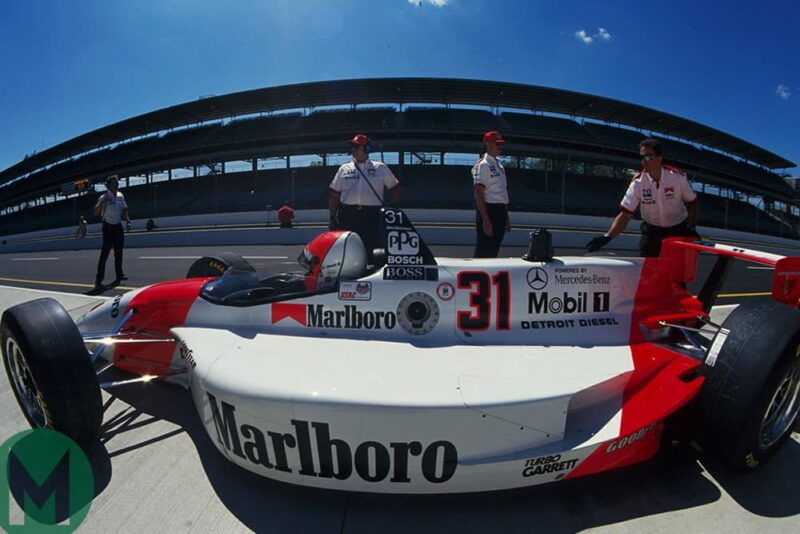
Penske kept the drivers on a tight leash in practice, limiting their speed so as not to reveal the true strength of their engine to rivals before the race
Motorsport Images
The engine ran on the dyno for the first time in the UK in late January and track testing started in February at the tiny, nine-tenths of a mile Nazareth tri-oval in Pennsylvania. In those days Penske Racing was based in Reading, Pennsylvania and the Nazareth Speedway was less than an hour’s drive away, so it was the perfect place to test in secrecy. Testing began amid frigid, snowy weather. “In those days we didn’t have chassis dynos and transient dynos,” notes Penske. “We just had to get the engine out on track and run it.”
Paul Tracy was the team’s young third driver and he recalls running many days at Nazareth during that cold February in ’94: “On some days it was so cold they gave me a snow suit to drive in. We had to take the seat out so I could fit in the car with this bulky suit, with rubber galoshes over the top of my driving shoes to insulate my feet. I’ve never been involved in any other development programme that operated at that level and expense. It was a huge undertaking by a superteam with a government style, top-secret programme and a whole skunkworks in the shop, right under everybody’s noses, and nobody knew what was going on.
“Roger was completely involved with the programme. He would call every night and ask if it had more power. He’d pepper you with questions and was totally motivated by the opportunity to pull the rug out from under everybody at Indy.”
“Roger was completely involved with the programme. He would call every night and ask if it had more power” Paul Tracy
At the time Penske owned the high-banked Michigan Speedway outside Detroit, the only track that could replicate or exceed the demands of Indianapolis. In April testing moved there and continued until the start of May when practice opened at Indy. Al Jr was also involved in the testing and was at the wheel the first time the engine ran 500 miles at Michigan on the first weekend in May.
“When we got to Michigan the engine would almost bust the tyres loose coming off the turns,” says Unser. “When you got on the throttle you could feel the torque. It blew up very often. They had other engines on the dyno back in England, so they would pull it apart right there in the garage to find out what had failed so they could call England and get to work on it straight away.”
Mercedes-Benz didn’t agree to put its name on the engine until early April. Prior to that, the project had been financed entirely by Penske and Ilmor. “Helmut Werner was the Mercedes CEO and I went to see him and said I needed some funding,” says Penske. “He said the one thing he wanted was Team Penske to go to Indy with all three cars with the engine. He didn’t want us to hedge our bets with one car with a conventional engine and we committed to that.”
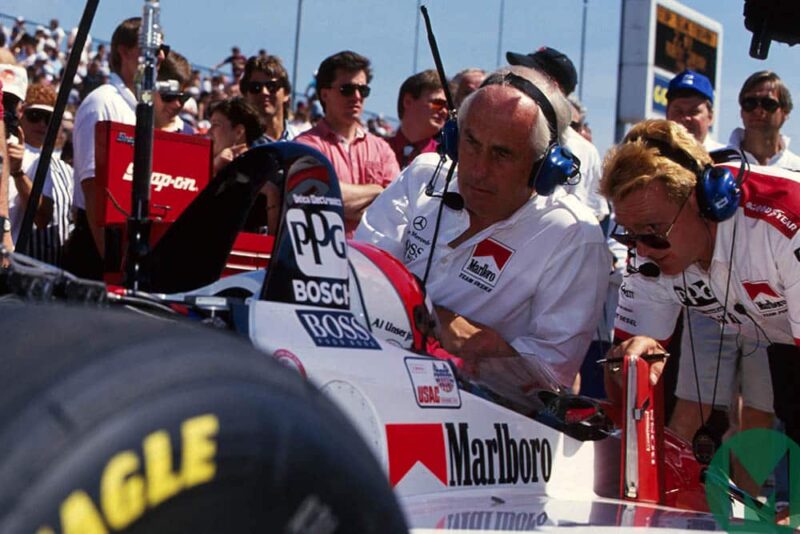
From the start of the race, the power and speed advantage of the Penske-Mercedes cars was clear
Motorsport Images
Heading to Indianapolis, Illien was totally confident. “Going into the month of May the engine was running flawlessly,” he says. “We did in excess of 10,000 miles that month and we didn’t have a single failure.” Illien had to remind the drivers not to push too hard and risk over-revving the engine. “The only concern I had was running hard into the limiter,” he says. “It was also a bit scary for them to smoke the tyres because that would take the edge away quickly. So I told them we didn’t want to be running into the limiter with a pushrod engine, and I think they behaved quite well.”
Penske was concerned that USAC would reduce the engine’s boost limit if it saw its true capability and he kept his drivers on a tight leash. “Roger was very worried that USAC would impose some restrictions,” recalls chief engineer Nigel Beresford. “So he personally oversaw the whole pop-off valve programme with USAC. You used to be given a primary valve and a spare, and Roger always made sure both valves were exactly right.”
Al Jr was enjoying himself immensely. “That was a wonderful month. The chief steward had the authority to reduce the boost at any time. If I ran within 2mph of the fastest guy Roger parked me for the rest of the afternoon.”
Beresford says the engine was better than the car. “The 1994 car in my opinion never handled as well as the ’93 car. The success of the ’94 car was due to the fact we had several innovative technologies. We had a sequential-shift gearbox and a third-spring-type suspension, which we had begun to develop in ’92. But Reynard had a better handle on aerodynamics and a car that was far less pitch-sensitive than ours. As we tried to match them our operating window became narrower, whereas they had a nice wide operating window. It wasn’t so much that we were sandbagging as the cars didn’t handle very well.”
Fittipaldi had won the 500 with Pat Patrick’s team in 1989 and with Penske in ’93. Emerson was a master of the month of May and looked likely to beat his team-mates to pole. But a Pole Day rain delay meant he had to make his qualifying run the next day in less favourable conditions, so Unser took pole with Fittipaldi third. Tracy started 25th, a second-day qualifier.
A key factor going into the race was that the rocker arm engine had substantially better fuel mileage than its competitors, which meant at least one less pitstop over the 500 miles — a huge advantage. “Most of the other teams didn’t have a chance because they had to make more pitstops than us because of fuel consumption,” says Illien. “We produced 1024bhp with the race engines and also made great fuel mileage compared to everyone else.
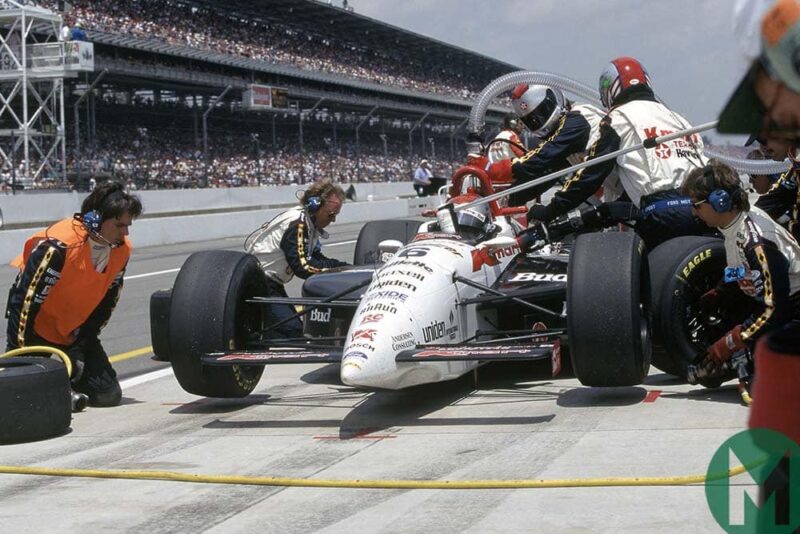
Mario Andretti was unable to get close to the Penske cars during what would be his final Indianapolis 500
Motorsport Images
“With a pushrod engine you have less cam and bearing surfaces which reduces the overall friction. You also have lower rpm and we had roller followers and lots of other things that reduced friction. That’s why even though the engine had a lot of horsepower it was still economical. It also had good combustion, it was fast-burning. We had good tumble motion and fast combustion. It was very economical.”
Unser led the opening laps before Fittipaldi took over, both of them running away from the field. Tracy dropped out when a turbo shaft bearing failed. Unser struggled with understeer and Fittipaldi was able to lap him, but Al Jr fought back, unlapping himself in a desperate effort to keep his hopes of winning alive. Emerson was equally insistent on putting the race on ice, however, and with 15 laps to go he tried a little too hard to repass his team-mate, hitting the rumble strip at the bottom of Turn 4 and losing control. He smacked the wall, ignominiously ending his race on the spot. “I was about half a foot too low and hit the apron,” he says. “I was very disappointed. It was a great shame because the car was flying and the engine was so strong.”
Unser went on to easily win his second 500. “It reminded me of when Parnelli and Andy Granatelli took the turbine to the Speedway in ’67,” he says. “They sandbagged all month and come race day they smoked ’em. And that’s what we did.”
“It reminded me of Parnelli and Granatelli in ’67. They sandbagged all month and come race day they smoked ’em. And that’s what we did” Al Unser Jr
Penske counts the victory as one of his most satisfying. “One of the highlights of my life was to have the Mercedes senior executives come into my garage on the morning of the race. They all had coats and ties on, and they took them off and put Penske-Mercedes shirts on and went up into the stands. To see our cars lead almost every lap of that race was a highlight of my relationship with Mercedes. It was one of our greatest wins.”
Illien echoes Penske’s pleasure. “That was the best project I’ve done,” he says. “It was so intense — it was day and night, every weekend. It was just a high through the whole month of May. How many times in your life can you go to a race with 200 more horsepower than everyone else? That was pure joy.”
Immediately after the race a handful of teams ordered rocker arm engines from Ilmor for 1995. “We started manufacturing engines,” says Illien. “We had castings ordered and started to really get into it.
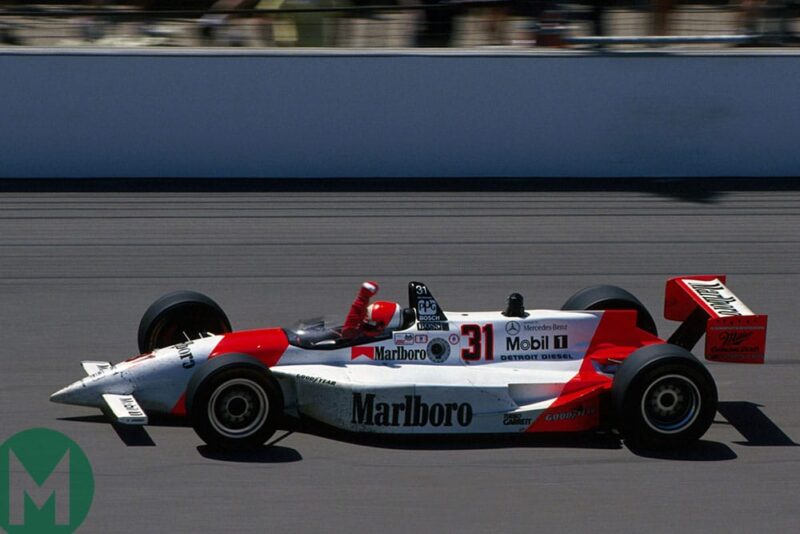
Al Unser Jr won the Indy 500 with ease, thanks in no small part to the Mercedes-Ilmor engine
Motorsport Images
But in the weeks following the 500 USAC twice reduced the rocker arm engine’s boost limit. “They pretty much outlawed it,” says Penske, shaking his head. “It was a draconian way to punish hard work, success and innovation when people had been running Buicks all that time and no one cared. Those Buicks were racing engines too. So it was disappointing. But on the other hand we got what we wanted. We won the race.”
Adds Illien: “Paul and I built that engine in the knowledge that we’d have only one chance to race it. We anticipated it would get banned. It was annoying, but it wasn’t a real disappointment because we knew that was going to happen.”
Reflecting on the rocker-arm engine, Penske veteran Clive Howell mourns the loss of independent thinking in Indycar racing. “That was probably the last of the projects at Indy where you could innovate. After that everybody started running more of the same stuff. The original ‘run what you brung’ innovative attitude of the Indy 500 has gone.”
After failing to qualify for the 1995 Indy 500, then missing the race for six years amid the CART-IRL war, Penske returned in ’01 and has since won the race five times. But of course today Penske has to race the same cars and engines as everyone else. In his heart, you know Roger would prefer it like it was in the old days.
